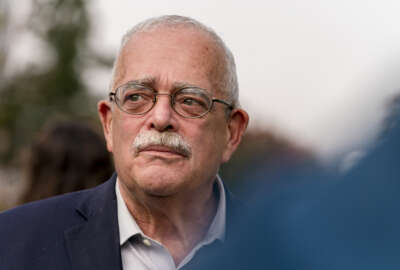

Hubbard Radio Washington DC, LLC. All rights reserved. This website is not intended for users located within the European Economic Area.
Like every other industry, the government has a continuing need for new talent. For some new ideas on how the federal government can stay in the competition, ...
Best listening experience is on Chrome, Firefox or Safari. Subscribe to Federal Drive’s daily audio interviews on Apple Podcasts or PodcastOne.
Like every other industry, the government has a continuing need for new talent. For some new ideas on how the federal government can stay in the competition, Federal Drive with Tom Temin turned to Bill Eggers, the executive director of Deloitte center for government insights.
Interview transcript:
Tom Temin: Now, this newest study kind of looks at both how the world of work itself has changed, and therefore, it’s changed the rules of the game with respect to recruiting and retaining people. That’s the basic thesis here?
Bill Eggers: Absolutely. That workplace of today is very different even than the workplace of three years ago, as we read about on a daily basis in the news.
Tom Temin: All right, so first of all, how did you go about kind of coming up with your recommendations for the government in the first place?
Bill Eggers: Well, I think it’s first just to understand what the main issue is. In the war for talent, the government is finding itself outgunned right now. When you talk to public managers looking to hire professional technical talent, we just always hear the same story, you can’t hire them, you can’t keep them. And this is at a time when the public sector is facing a whole slew of complex challenges from climate change to cybercrime that require these very highly skilled workers. And while it’s always been difficult for government to sometimes attract that top talent, especially young tech savvy professionals today, it often feels close to impossible in this sort of job market that we’re in which I haven’t seen anything like this and decades and decades. You know, most people don’t realize it, but from January 2020 to January 22, government lost more than 600,000 workers more than manufacturing, wholesale trade and construction combined. And when you look at the federal workforce, only 8% is under the age of 30, compared to close to 25% in the private sector. And at the same time, we are starting to see a lot of retirement eligible employees are accelerating retirement plans, the highest percentage at the state and local level since the survey actually began in 2009. So government has a lot of headwinds facing right now as it’s trying to attract talent in this area where they dramatically need to increase the workforce component of those in the Gen Z and millennials.
Tom Temin: And heading your list of ways for the government to attract and retain talent is flexibility in where, when, how, people work. And that seems to be the government’s weakest spot, because it’s the most rigid in many ways, work environment of all.
Bill Eggers: When you look at job postings, when you look at all this survey data, it’s really clear that for Gen Z, millennials, flexibility across all dimensions is really table stakes, it’s the most important thing. They’re looking for jobs that work for them, which means better compensation, better work-life balance and an environment where they feel a sense of belonging. And if you have jobs that say that you’re going to have to come into the office five days a week, and there’s no flexibility there, the amount of job applications you’re going to get is dramatically, dramatically lower than other sort of positions that offer more flexibility. And a couple other major aspects of this generation of workers is that they’re increasingly prioritizing their physical and mental health well being and seeking employers who are going to do the same. 73% are seeking mental health coverage, 72% say health and wellness stipends are critical, and they also just want a job that makes a difference. So this notion of well being, flexibility, pay. And of course, there’s always purpose and impact, which has always attracted people to government. But there’s these other factors now that in all this survey evidence show they are just as important, and government’s going to have to compete in those areas.
Tom Temin: It looks like government agency by agency is beginning to show that flexibility, at least with respect to where and when people work. In terms of the hours they choose to work or the location, almost by default, because they have no other choice, even with the employees. And this is in the absence of any congressional mandate here or any even White House kind of overarching policy, except it seems to be, do what works best for you.
Bill Eggers: Yeah, and I think that is critical. And I will say that the questions we get the most often around this area are how do you make hybrid work actually work? It’s more difficult to do hybrid environment than an all remote or an all in-person, as we found when we tried to do hybrid meetings and so on. And you have to focus on all those elements, a culture of respect and inclusion, belonging, and also how do you do mentor in this sort of environment? How do you replace those water cooler conversations? How are you intentional about where work actually happens when you actually do need to bring people together? And I also think there’s a big piece of this just around opportunities. We’re seeing a very entrepreneurial generation that they want to seek opportunities to do entrepreneurial work at work. And one of the ways that governments can do this is encouraging workers to pursue diverse projects. So investing in resources like internal talent marketplaces. And these are forms where employees can look for rotations, projects, new roles within the organization to really provide this mechanism for engaging in projects that they’re passionate about. They’re gaining experiences in new roles. We see this at NASA, with their talent marketplace, the armed services now have talent marketplaces, as does the Department of Energy and the Canadian government has something called the free agent model. And those are all examples of offering people diverse kinds of experiences while working in government, which is actually one of the biggest benefits that governments can really sell to employees as an attractive place to work.
Tom Temin: We’re speaking with Bill Eggers, he’s executive director of Deloitte’s center for government insights. And many of those measures can be done at the discretion of federal managers and executives, if only they’ll choose to do that. But there’s one on the list here, individualized rewards and non-traditional benefits. And that gets into the area of title five, and so forth. And you just can’t hand out bonus checks willy nilly, maybe at the state and local level, but at the federal level, is there any pathway toward that kind of individualization?
Bill Eggers: Absolutely. The key thing is that there are lots of different ways of going about this. It’s not just a one size fits all sort of thing. You know, by allowing employees to choose their rewards, you can boost satisfaction. So one employee, for example, might value a childcare stipend or voucher points to use for grocery delivery, while another might prefer a retail card or others might be really interested in making sure that they have very good mental health coverage and encouraging conversations on the topic. So you can foster trust in that way. But there are, you know, a lot of examples where governments are beginning to do this. The issue governments have is that the private sector is moving really, really rapidly towards offering kind of unprecedented benefits in a lot of these areas, and certainly around well being, and so forth. And so that’s an area, I think that it’s important for government, as an employer who’s also trying to model good behavior for the private sector, to be more at the cutting edge and less a laggard in this area going forward. And you know, the thing we haven’t talked about so far is just the whole pay issue, which is, it’s very apparent that pay matters and compensation right now, by Gen Z is the most important factor behind their employment choices, decisions to switch jobs. And so we’re going to need more of what we’ve seen at the Department of Homeland Security with their cyber talent management system, which is more flexible ways of having competitive pay and time pay increases to mission impact instead of just tenure or recognition payments. Unlike the general schedule, the DHS cyber system doesn’t beat your automatic pay increases, it offers a lot more of this sort of flexibility and for especially these highly technical sort of areas, that’s going to be really, really critical for government to be able to recruit people out of grad school or from other sorts of positions, which are really, really crucial right now for government to meet its mission impact.
Tom Temin: That’s right. There are a lot of flexibilities in the system now. In terms of hiring, I think the number varies. 125 job flexibilities and you see these reports from time to time that agency managers only use a handful of them. But there’s probably tools that are just simply sitting in a bucket. If someone wanted to exercise them, they could pull them out and loosen them up and probably try it.
Bill Eggers: No, absolutely. I think that’s what you will hear often from OPM and OMB is that agencies have a lot more flexibility in this area than they’re actually looking. You know, and on the good side of things the OPM’s recent strategic plan pledged to make the federal government a model employer and transform OPM into a leader in human capital management. And that plan included a bunch of hiring objectives in terms of increases in military spouses, 10 percent increase in early career employees. And over the long term, OPM is really focused on a government-wide policy and coordination with the CHCOs throughout the federal government, so that they can make a lot of this happen. But I think it is going to require managers who are hiring people in the human capital shops, really understanding all of those flexibilities and understanding that it’s absolutely going to be critical to use all the flexibilities they have and and then additional flexibilities they might need to ask for them. At the state and local level, there’s actually fewer flexibilities oftentimes than you see at the federal level. And so that might actually require legislation at the state level or city council level to give more of this sort of flexibility, which has become table stakes in today’s workplace.
Tom Temin: Bill Eggers is executive director of Deloitte center for government insights.
Copyright © 2024 Federal News Network. All rights reserved. This website is not intended for users located within the European Economic Area.
Tom Temin is host of the Federal Drive and has been providing insight on federal technology and management issues for more than 30 years.
Follow @tteminWFED



